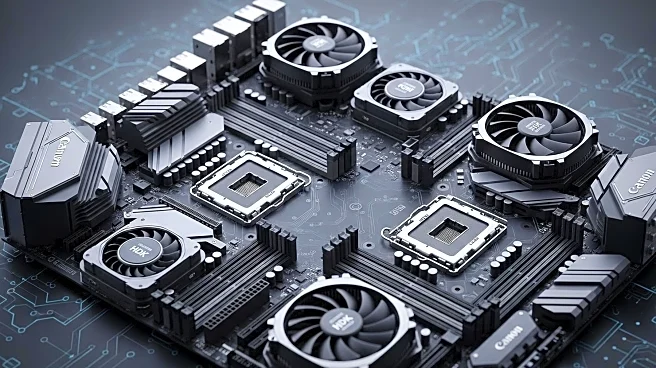What is the story about?
What's Happening?
Intel has announced details of its upcoming client processor lineup, the Intel Core Ultra Series 3, codenamed Panther Lake, along with its next-generation Xe3 graphics architecture. The new processors will feature up to 16 performance and efficiency cores, promising over 50% higher CPU performance compared to previous generations. The Xe3 graphics architecture will include up to 12 Xe cores, offering more than 50% better performance than Lunar Lake GPUs. Intel also introduced XeSS 3, an AI upscaling technology similar to Nvidia's DLSS, capable of boosting frame rates by up to four times. Additionally, Intel confirmed a collaboration with Nvidia to develop and sell x86 system-on-chips for personal computers featuring Nvidia RTX GPU chiplets, and custom x86 CPUs for data centers, which Nvidia plans to use for its AI infrastructure platforms.
Why It's Important?
The unveiling of Intel's Panther Lake processors and Xe3 graphics architecture marks a significant advancement in computing technology, potentially enhancing performance and efficiency in personal computers and data centers. The collaboration with Nvidia indicates a strategic partnership that could strengthen Intel's position in the competitive semiconductor market, particularly in AI and graphics processing. This development is crucial for industries relying on high-performance computing, such as gaming, data analytics, and AI research, as it promises improved processing capabilities and energy efficiency. The introduction of XeSS 3 further highlights Intel's commitment to leveraging AI technologies to enhance user experiences.
What's Next?
Intel's collaboration with Nvidia is expected to lead to the development of advanced computing solutions, potentially influencing the design and capabilities of future personal computers and data centers. As Intel and Nvidia work together on these projects, stakeholders in the tech industry may anticipate further innovations in AI processing and graphics technology. The deployment of these new technologies could prompt responses from competitors, potentially leading to increased investment in research and development to maintain market competitiveness.
Beyond the Headlines
The partnership between Intel and Nvidia may have broader implications for the semiconductor industry, potentially influencing market dynamics and competitive strategies. As both companies leverage their strengths in processor and graphics technologies, this collaboration could set new standards for performance and efficiency in computing, impacting consumer expectations and industry benchmarks. Additionally, the focus on AI upscaling technologies like XeSS 3 reflects a growing trend towards integrating AI capabilities into hardware solutions, which could drive further innovation in AI applications across various sectors.
AI Generated Content
Do you find this article useful?















